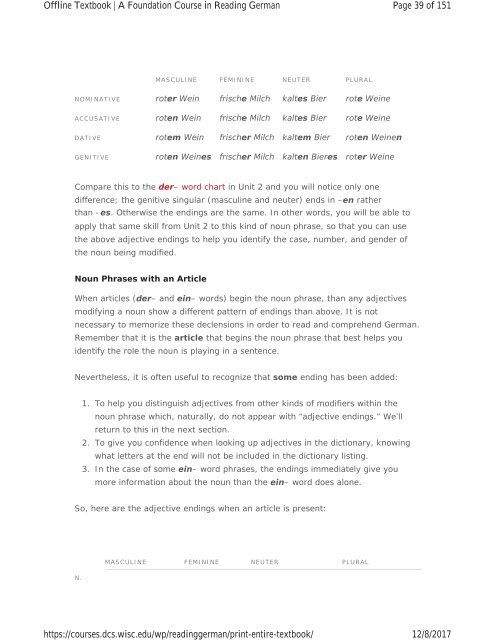A Foundation Course in Reading German, 2017a
A Foundation Course in Reading German, 2017a
A Foundation Course in Reading German, 2017a
Create successful ePaper yourself
Turn your PDF publications into a flip-book with our unique Google optimized e-Paper software.
Offl<strong>in</strong>e Textbook | A <strong>Foundation</strong> <strong>Course</strong> <strong>in</strong> Read<strong>in</strong>g <strong>German</strong><br />
https://courses.dcs.wisc.edu/wp/read<strong>in</strong>ggerman/pr<strong>in</strong>t-entire-textbook/<br />
Page 39 of 151<br />
12/8/2017<br />
MASCULINE FEMININE NEUTER PLURAL<br />
NOMINATIVE roter We<strong>in</strong> frische Milch kaltes Bier rote We<strong>in</strong>e<br />
ACCUSATIVE roten We<strong>in</strong> frische Milch kaltes Bier rote We<strong>in</strong>e<br />
DATIVE rotem We<strong>in</strong> frischer Milch kaltem Bier roten We<strong>in</strong>en<br />
GENITIVE roten We<strong>in</strong>es frischer Milch kalten Bieres roter We<strong>in</strong>e<br />
Compare this to the der– word chart <strong>in</strong> Unit 2 and you will notice only one<br />
difference; the genitive s<strong>in</strong>gular (mascul<strong>in</strong>e and neuter) ends <strong>in</strong> –en rather<br />
than -es. Otherwise the end<strong>in</strong>gs are the same. In other words, you will be able to<br />
apply that same skill from Unit 2 to this k<strong>in</strong>d of noun phrase, so that you can use<br />
the above adjective end<strong>in</strong>gs to help you identify the case, number, and gender of<br />
the noun be<strong>in</strong>g modified.<br />
Noun Phrases with an Article<br />
When articles (der– and e<strong>in</strong>– words) beg<strong>in</strong> the noun phrase, than any adjectives<br />
modify<strong>in</strong>g a noun show a different pattern of end<strong>in</strong>gs than above. It is not<br />
necessary to memorize these declensions <strong>in</strong> order to read and comprehend <strong>German</strong>.<br />
Remember that it is the article that beg<strong>in</strong>s the noun phrase that best helps you<br />
identify the role the noun is play<strong>in</strong>g <strong>in</strong> a sentence.<br />
Nevertheless, it is often useful to recognize that some end<strong>in</strong>g has been added:<br />
1. To help you dist<strong>in</strong>guish adjectives from other k<strong>in</strong>ds of modifiers with<strong>in</strong> the<br />
noun phrase which, naturally, do not appear with “adjective end<strong>in</strong>gs.” We’ll<br />
return to this <strong>in</strong> the next section.<br />
2. To give you confidence when look<strong>in</strong>g up adjectives <strong>in</strong> the dictionary, know<strong>in</strong>g<br />
what letters at the end will not be <strong>in</strong>cluded <strong>in</strong> the dictionary list<strong>in</strong>g.<br />
3. In the case of some e<strong>in</strong>– word phrases, the end<strong>in</strong>gs immediately give you<br />
more <strong>in</strong>formation about the noun than the e<strong>in</strong>– word does alone.<br />
So, here are the adjective end<strong>in</strong>gs when an article is present:<br />
N.<br />
MASCULINE FEMININE NEUTER PLURAL


















